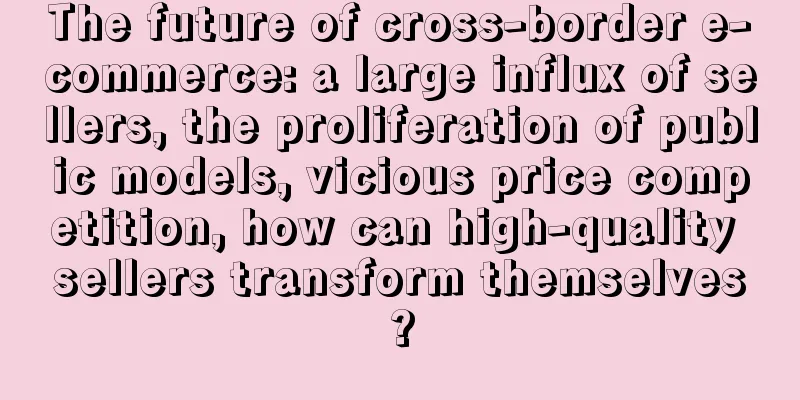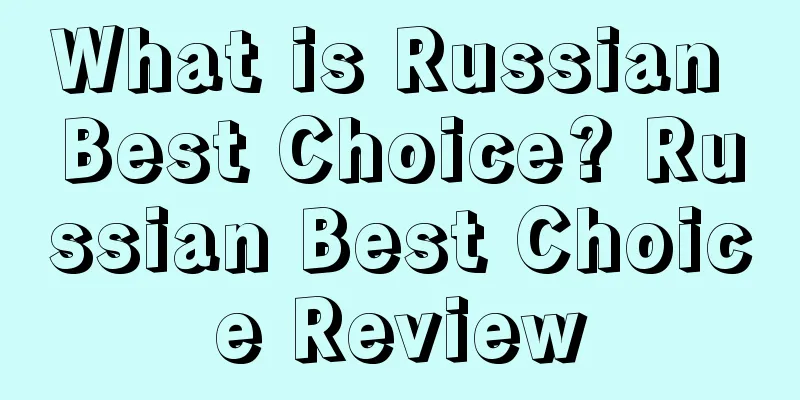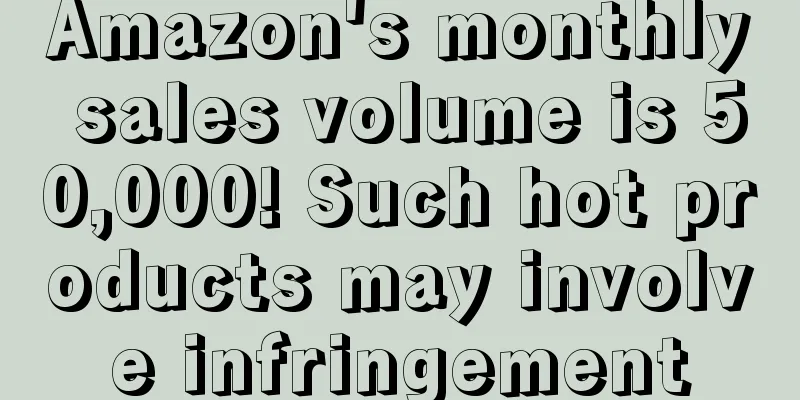The future of cross-border e-commerce: a large influx of sellers, the proliferation of public models, vicious price competition, how can high-quality sellers transform themselves?

|
About the author : An executive of a cross-border e-commerce company listed on the New Third Board. He has extensive industry experience, and his work experience includes product development, supply chain management , integrated operations, and corporate strategy . What is "Brick Throwing Set"
"Original Record" 2017 is the transformation year for cross-border e-commerce. Most of the big sellers that everyone knows are transforming. Some big sellers that are foresighted but unknown are also accelerating their transformation (such as Shenzhen Chenbei Technology, and the unknown brand Etekcity). I believe everyone is also very clear about the reasons why they need to transform. A large number of individuals and small and medium-sized sellers are involved in the e-commerce industry, the proliferation of public models, vicious price competition, etc. So what should we do in this critical year of 2017? What is the core of cross-border e-commerce in the future? Today I will give you a simple sharing, I hope it will be helpful to everyone. First of all, let me talk about my views on the future of the cross-border e-commerce industry. I think the future development of cross-border e-commerce will be based on online, offline, brands, R&D teams, big data and IT, patents, supply chain systems, and after-sales services. If you want to survive, you must do relatively well in at least one of these aspects. These are what the leading cross-border companies are currently doing or planning to do. I will also give some well-known e-commerce examples to illustrate this so that you can understand it better. The chance of success for pioneers is always higher I don't know how you understand the concept of online, but my understanding is that everything related to online retail is classified as online. Some sellers build their own websites, and some sellers are on third-party platforms, such as AMA/Walmart in the United States, JD.com and Tmall in China, Otto in Germany, etc. Online sales are destined to enable us to overcome the regional sales bottleneck in physical operations and allow our products to be sold all over the world; Global Easybuy, Paton and other companies are relatively well-known in the industry, and all well-known platforms are involved. Here I give individuals and small and medium-sized sellers a suggestion to catch up. Popular platforms may not be the most suitable for you. The chance of success for pioneers is always higher. Pay attention to new platforms (such as new platforms or new types of platforms, Walmart, WISH, etc.), pay attention to the bonus period of various platforms or social media, pay attention to new markets, and pay attention to suppliers outside the Pearl River Delta. In this way, old products can also be sold at sky-high prices, and rookies can also fly first. The picture gives you an example of a seller on the Mexican site. There is little competition and you can calculate the profit yourself (I will give you a special topic on cost accounting in the future). Offline I won’t explain the concept of offline in detail, as everyone is very clear about it. However, it is not appropriate to explain these contents in detail here. For individuals or small and medium-sized sellers, you have not yet reached this step. I will simply give you an example to understand it. Please see the picture: ANKER Seattle offline store Amazon's offline experience store AMZ GO I believe some of you know the information about the offline physical stores that a certain Global e-commerce company is preparing for, the entry of a certain Pepsi e-commerce company into the domestic e-commerce market, etc. In addition to the example of ANKER's offline store mentioned above, here I would like to share a way for an online brand to go offline. As we know, there is a very interesting thing in the e-commerce market, which is the "time difference" between B2C and B2B. Friends who are doing both B2B and B2C know that often within half a year after popular B2C products are put on the shelves, foreign supermarkets often start to become B2B, using larger quantities and better-priced products to impact online sales. In fact, I have also encountered such a situation. For such a situation, we chose a method, which is to do B2B and B2C together. The B2C side develops our new products, builds our brand, and earns our profits. After earning enough profits in the main market of the B2C side, the sales staff also promotes our products on the B2B side, such as offline chain supermarkets, and starts B2B sales at the same time. Often at this time, our products will achieve better quality and price, and at the same time feedback to the B2C side to support our competition, forming a chain of advantages. For our core categories of products, we negotiate with the B2B side to give extremely advantageous payment terms and prices, in exchange for our brand autonomy in the offline retail end, and use the resources of chain supermarkets to promote our products offline. brand Regarding brands, I have thought a lot but I don’t know how to start, because brand descriptions are difficult to write, it’s something that is hard to express; I will just share my opinion, brands are still divided into online and offline brands, offline brands can be called real brands, it is very easy for offline brands to radiate online, if it is an online brand, what you need to ensure is your exposure rate in the category, or the proportion of the homepage or even the TOP100 products; for example, this brand: R&D Team I will not say much about the importance of the R&D team. You can see it from the Amazon global investment plan at this year's Hangzhou Annual Meeting. Companies without their own development teams are doomed to have difficulty surviving in the long run. Any platform will only support these companies with core competitiveness. Of course, Amazon is also playing a big game here (it is not willing to be just an online company. The previous VE exposed AMZ's ambition. The global investment plan released at the Hangzhou Annual Meeting is a naked confession that it wants to compete with offline retailers). Everyone knows that public molds are not viable now, but many people define R&D as making their own molds and making products, and doing some micro-innovations, but this is actually not comprehensive. My understanding of real R&D is that at least the big modules such as appearance ID, product definition, functional innovation, product positioning, quality standards, and user experience must be considered to be real R&D. As for making molds, this is just called differentiation. If you go into more details, you must have ID, structure, electronics, software, quality planning engineers, and product managers. ANKER in the industry does the best. Their business team is in Changsha, and the product supply chain team is in Nanshan, Shenzhen. R&D personnel account for about 50% of the company's total staff. If you want to see whether it is correct, you can search for recruiters of major e-commerce companies and you will find out. The strategic realization of any company comes from people, so the recruitment information of many companies will expose their strategic plans. Big data and IT I won’t talk about IT, just systems like ERP, OA, and MES (such as the ERP developed for e-commerce by a certain animal gang), which are similar in every company. The software of the former company of the author of this post was developed by his own Indian software branch. Here I will focus on big data. The author of this post is one of the first companies in the industry to start big data and apply big data. I participated in the construction of big data principles throughout the process; I can only say that it was useless in the first year, but it was a magic tool in the second year. . . We cannot reveal too much about confidential information. As for the core secrets of the company, we will just talk about the modules that big data can be applied to, order forecasting, product development and elimination (it can directly capture the trend, which is awesome), procurement cost forecasting, logistics cost forecasting, competitor analysis, and hot product promotion forecasting. The data sources are either from the Internet or our own data, and some data is obtained from account managers. patent I believe everyone has experienced the blocking of your account or listing due to infringement. This is just the initial stage. I believe that some big sellers have experienced the most painful one like us. A product has been BS, but suddenly it is accused of patent infringement and has to be removed from the shelves. At this time, I panicked. What should I do? After researching and researching, I suddenly found that the opponent has basic patents or patent authorization, but we don’t. Then there is nothing else. The listing is blocked, a lot of products are stagnant in FBA, and then there are a lot of losses, a series of clearance plans, and it is simply painful; for example, many big sellers now see the market and profits of small household appliances and are intervening in the small household appliances market. I can only say that the current level of attention paid to intellectual property rights abroad is unmatched by domestic sellers. As long as you check, basic patents are everywhere. Once you succeed, people sue you, and you will be finished. If you don’t develop products yourself, don’t apply for your own patents, or don’t buy patent authorization, you will be slaughtered when you succeed. PS: Most small appliance sellers are overseas sellers. Don’t ask me why I know this, because I used to be one of them. Supply Chain The supply chain will have some ideas and practices that most people have not been exposed to (the focus will be on the Forcast planning management module and the supplier management module), so the supply chain and after-sales service will be discussed separately as topics in the following sharing. |
>>: No orders? You should take a look at this product development idea
Recommend
What is Latestdeals? Latestdeals Review
Latestdeals is one of the largest deal communities...
How do new Amazon sellers find reviews?
1. Those with V status have only done some certif...
Pinduoduo becomes Amazon's source of goods? 60 people involved in the case, cross-border fraud dens were cleared!
▶ Video account attention cross-border navigation ...
Southeast Asian sellers gather together! DNY123 Southeast Asian seller navigation is newly released and waiting for you to join!
DNY 123 http://www.dny123.com/ Sellers on Southeas...
An Amazon employee who forced his staff to leave the company was arrested. Who exactly is Dark Horse Technology?
September 19th news, according to foreign media r...
Amazon's Difficult Operational Journey
Preface of the Little Clone: This week’s Amazon s...
More benefits! Amazon coupons for limited time discounts!
Every time Amazon is mentioned, sellers always hav...
Urgent! A large number of Amazon stores were closed this morning! Request for information
This morning, our discussion group was instantly ...
What is Yanhang Going Global? Yanhang Going Global Review
Yanhang Overseas helps Chinese brands successfully...
Do you really understand Facebook's external traffic?
Have you noticed that most Amazon service provider...
What is Shop Social? Shop Social Review
Shop Social is a tool that integrates your shoppab...
What is Qubi'an? Qubi'an Review
Fubi'an is affiliated to Shenzhen Qianhai Aifu...
What is Dibz? Dibz Review
Dibz is an easy-to-use SEO tool that allows users ...
Profits have dropped by one-third! Sellers can no longer rely on their old profits!
Amazon is becoming increasingly untenable. Since t...
What is Handled by AliExpress? Review of Handled by AliExpress
Handled by AliExpress is a self-operated buyer exp...









